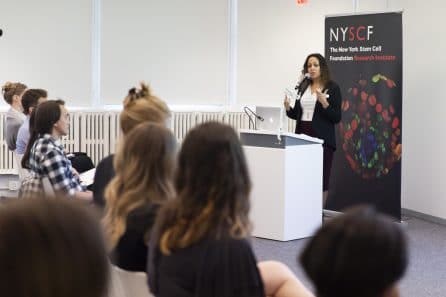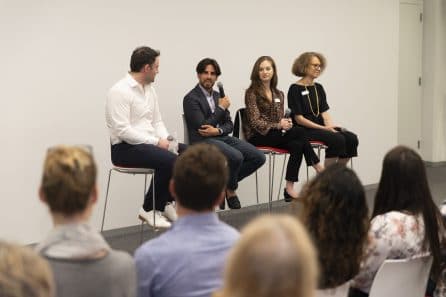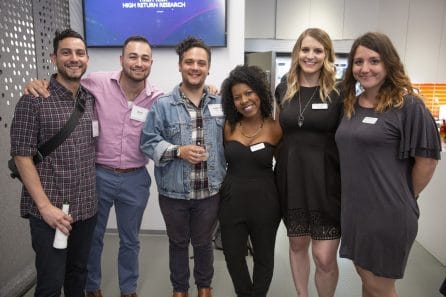Exploring the Promise of Regenerative Medicine at “Stem Cells in the City”
NewsThe key to fixing many devastating diseases and injuries could very well lie in regenerative medicine. The secret? Stem cell research.
At NYSCF’s recent event, “Stem Cells in the City,” hosted by our Junior Leadership Council, young professionals heard from NYSCF scientists who are leveraging the regenerative potential of stem cells to find innovative and viable therapies for Alzheimer’s, Parkinson’s, macular degeneration, bone disease, and more. Such “regenerative medicine” approaches hold extraordinary promise for providing personalized relief to countless patients.
What is Regenerative Medicine?

“Regenerative medicine is an umbrella term for therapies that repair, replace, or regenerate parts of the body affected by disease,” explained NYSCF Senior Director of Scientific Outreach Raeka Aiyar, PhD. “There are already over 900 companies worldwide working in regenerative medicine, and over one thousand clinical trials are underway.”
Stem cells are a crucial driving force for regenerative medicine. Many ailments result from a dysfunction or loss of cells in a certain part of the body. Our stem cells have the potential to generate cells that can replace damaged or diseased cells, restoring normal function and seamlessly integrating into the body since they are derived from patients themselves.
How Can Regenerative Medicine Help Treat Bone Defects?
Bone defects and injuries are usually treated with bone grafts, taken either from another part of the patient’s body, a donor bone bank, or with synthetic substitutes. However, these treatments carry several complications: they can cause immune rejection, they don’t work well for trauma patients, and children outgrow them.
NYSCF—Ralph Lauren Senior Research Investigator Giuseppe Maria de Peppo, PhD, uses stem cells to create patient-specific bone with the potential to integrate into the body’s dynamic environment and overcome these limitations.

“We take skin cells, turn them into stem cells, and then turn these stem cells into bone-forming cells,” explained Dr. de Peppo. “We combine the cells with biomaterials, or frameworks, to help form a graft in the size and shape of the defect to be replaced.”
These personalized grafts have the potential to form nerves, connective tissue, and vasculature, are less likely to be attacked by the immune system, and can theoretically and grow and change in sync with the recipient’s body. They already show tremendous promise for treating millions affected by bone defects, and Dr. de Peppo is optimistic about the next steps for this technology.
“I’m excited for the future of tissue engineering. I think we’ll be able to do exciting things like 3D bioprinting, allowing us to really position cells and capture even more of the complexity of the human body, leading to better treatments.”
How Can Regenerative Medicine Restore Vision?
Age-related macular degeneration (AMD) is a disease which affects 8 million Americans and can lead to severe vision loss due to death of retinal pigmented epithelial (RPE) cells in the eye. NYSCF is pursuing its first cell replacement therapy by generating RPEs in the laboratory to introduce into patients, which other clinical trials have demonstrated has the potential to cure the disease and restore their vision.
“There are actually a number of biotech companies creating patches with RPE cells on them that are implanted into the eye to treat people with macular degeneration,” explains NYSCF Chief Strategy Officer Lisa Strovink. “But most everybody is taking the same approach. They’re making a generic patch with donor cells from one cell line, and patients have to take immunosuppressants so that they don’t reject the implant. We think there may be a better way.”

NYSCF’s approach involves seeding a patch with healthy RPE cells engineered from a patient’s own stem cells, a more personalized option that could provide important advantages.
“The idea is that with a patch containing patient-derived RPE cells, patients wouldn’t have to immunosuppress, and the graft would work better and last longer.”
This work is currently in preclinical development at the NYSCF Research Institute, where scientists are preparing the therapy for clinical trials.
Will Regenerative Medicine Be Possible for Neurodegenerative Diseases?
Perhaps one day. For example, NYSCF – Robertson Stem Cell Investigator Malin Parmar, PhD, is in the process of developing a cell therapy for Parkinson’s. However, a major obstacle in conducting regenerative medicine for neurodegenerative diseases is the fact that we know much less about their causes than we do about the causes of diseases like AMD. So before we start using stem cells to treat them directly, we first need to understand exactly what is going wrong. This has traditionally been difficult, but stem cells have opened the door for much more effective study of how diseased cells develop and dysfunction.
“For diseases like multiple sclerosis or Alzheimer’s, we still don’t really know exactly what causes the degeneration, and we cannot look into a living brain to see what’s happening.” said NYSCF Senior Research Investigator Valentina Fossati, PhD. “But we can transform stem cells into all the different cell types in the brain, which lets us see exactly how the cells die, just like they would in a patient.”
This information can then be used to develop therapies that target the disease where it starts. We can also use stem-cell-derived brain cells for another important feat: drug testing.
“For the past 50 years, we’ve been testing drugs in mice, but the sad truth is that 99% of the drugs that came out of these studies failed, because we aren’t mice,” explained Dr. Fossati. “But when we have patient-derived brain cells in a dish, we can test drugs on them and see which therapies work best on human cells, and which ones work best for which patients.”